The Lagos State Government is making good on its decision to foreclose dredging at the Aja-Badoreh Road corridor and most other locations around the state. It has given a notice to sand dealers and others whose coordinates are affected to relocate to other places.
When the Commissioner of Waterfront Infrastructure Development, Prince Adesegun Oniru, addressed stakeholders in early March 08, it was to read the Riot Act to confirm the uncomfortable news state government officials had been telling them in the previous weeks. According to him, new rules were being worked out.
In the beginning of the face-off with the dredging sector, after Aja-Badoreh axis was clamped down, other dredging outfits scattered in Ikorodu and Badagry parts of Lagos were also told to close shop temporarily in what was then said to be a measure to bring all operators into line with environmental and regulatory propriety. Whereas Aja-Badoreh operators were held off by the Office of the Special Adviser to the Governor on Mineral Resources Development (popularly called OSAMA), operators at Ikorodu were put on hold on the orders of the Lagos State Waterfront Infrastructure Development ministry.
At a stakeholders meeting called by the OSAMA at the time, four key officials of the agency conveyed the new order to dredge proprietors without mincing words. The operators were mainly from the Lekki-Ajah corridor and most of them had had their dredging sites under lock since late November 2007.
Addressing the audience during her turn in the discussions, Mrs Raji, the environmental compliance officer of the agency said that the government had decided to close down activities on all the Ajah-Badoreh Road sites and that when reopened, dredging activities would be allowed for only a very few number of operators. She did not name those operators but advised all the affected operators to begin earnestly searching for new dredging sites. She said the state government had decided to relocate all of them. Mrs Raji gave other tit-bits of information which she said inhered from the Lagos state law on mineral resources development, otherwise known as Law 22, passed by the state House of Assembly in 2004.
In his own address, the acting permanent secretary of the agency, Mr Agboola Blaise, reiterated the determination of the agency to implement the state law on sand mining and mining of other minerals as contained in Law 22. He read out a few sections of the law that permitted the state government to regulate dredging activities within its boundary, saying that in view of the disorderly nature exhibited by the dredging companies in their activities, the state government could not fold its arms and watch helplessly the flagrant disregard of laid down rules.
The chairman of the enforcement task force of the agency, Mr Bayo Sulaiman,.in answer to the questions and comments by the stakeholders recounted the origins of the recent closure of dredging activities as a routine tour by the state governor, Mr Babatunde Fashola, in November when he saw the level of destruction haulage trucks and dredging activities had done to the newly constructed Ajah-Badoreh road.
He said the Governor was angered by the massive heaps of sand along the road some of which were too close to the road. According to him, the leaders of the community were on hand to protest to the Governor their complaints against the sand miners and that even the road contractor, PW Nigeria Ltd, registered protests with the Governor concerning their disappointment with the dredging companies. Moreover, he accused the dredging companies of not paying the right taxes to the state government stating that over 80% of the operators on that axis evaded paying their due taxes. He challenged any of them that disagreed to produce their tax receipts.
In fact, it was a harvest of woeful news as the agency’s director of geological services, Mr W Baruwa Etti, revealed that the state government was of the belief that except their activities were curtailed or properly regulated Lagos may suffer a tsunami hazard. He premised this conclusion on his view that the Ajah-Badoreh river was being over-dredged and that this could instigate a hazard. Although some of the operators tried to correct this impression, Mr Etti maintained that there was over-dredging.
The operators argued that their dredging activities would deepen the channel and make it more suitable for inland water transportation. However, the onus was heavily against the dredge operators because even from their own ranks rang out strong allegations that many of their members did not do things right, did not pay the proper fees to government and even operated fraudulently by dredging and stockpiling sand in many sites using only one letter of consent from the state government.
This allegation formed part of the address of Mrs Raji who said such practices would no more be tolerated. She reeled out other do’s and don’ts including a N1m fine or 6 years imprisonment (or both) for any company or operators found breaking the laws; yearly renewal of consent letter with N200,000.00 every first of January; tax returns verified every first of January.
When it came time for the operators to make their plea, they appealed for a moratorium from the state government to sell off their accumulated stockpiles so as to pay off bank loans and prepare for relocation. As a sweetener, they agreed to sign an undertaking with the state government for the upkeep of best practices on the new road and in their sand stockpile sites, including sweeping the road and ensuring that haulage trucks use tarpaulin to cover their loads and turning at the right spots to avoid climbing over kerbs and gutters, etc.
WHAT ARE THE IMPLICATIONS OF DREDGING FROM AFAR USING A MEDIUM-SIZED OR SMALL DREDGER FOR A SAND MINING?
When 2008 began with the news of change in the way dredging will be done in Lagos, DDH set out to gauge the possible shift in operational parameters. One of the realities that will be faced by dredging companies is coping with the total specified distance between the dredger and the bund wall. Going by the new policy of the Lagos State government, this distance will be made up of (a) the specified distance between the burrow pit and the shoreline and (b) the specified distance between the shoreline and the bund wall. We asked some dredge manufacturing companies to analyze this development and give their assessments of the outcome of various variables. Here is how Dredging Supply Company of Louisiana which supplies some Nigerian dredges has to say on the issue.
“The correlation of the discharge distance and the terminal elevation (i.e. total head conditions) plays a vital role on the efficiency and performance of a dredge. Dredges are typically limited by their excavation means (cutter, etc), dredge pump limitations or horsepower limitations. With the scenario you are describing with the longer discharge distances, this becomes a factor concerning the dredge pumps and horsepower. Below are a series of graphs to illustration the effects of a long discharge line (1.5 km) and how the dredge becomes limited.
For the graphical demonstration below, let’s assume a dredge and dredging job with the following characteristics.
- 457mm x 406mm (18”x16”) Marlin Class Dredge – underwater pump
- Dredge pump power – 746kW (1000hp)
- 149 kW (200hp) cutter
- 457mm (18”) HDPE plastic dredge discharge pipeline with an inside diameter of 401mm (15.775”)
- 10m (33’) dredging depth
- 3m (10’) terminal discharge elevation
- Material is a well-graded medium sand
- The material is compaction rate is Firm (12 blows per foot)
- Operating Efficiency of 70%

Our production curves show both a Maximum and also an Expected curve. Theoretically, the dredge is capable of the producing the maximum production but with real life project conditions, it is unrealistic to expect this production rate. We use 70% of the Maximum curve to provide the Expected output curve which can be attained under real life project conditions.
You will notice in the graph above that the EXPECTED production rate starts out around 770m 3 per hour. The dredge can only maintain this production rate out to approximately 287 meters of discharge line distance. The production rate drops off as it moves through the discharge line. At the final discharge point, 1,500 meters, the EXPECTED production rate is down to 130m 3 per hour.
As you can see that production drops off as the distance increases, but let’s try to understand the factors that attribute to this. One graph that helps demonstrate what is happening in the pipeline is the concentration graph. Below is the concentration graph indicating the percent solids by volumetric measure. It is fairly obvious that the concentration by volume (Cv) follows a similar curve as the does the throughput curve.
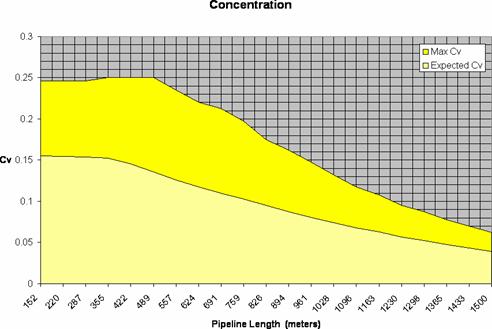
The next series of graphs allow us to review the overall conditions and limitations that we are seeing with this dredging job. As you review this graph you will see that we become limited by the power available to the dredge pump at about 355 meters of discharge length. At about 759 meters of discharge length we have reached the maximum speed of the dredge pump and we are still at full power. Soon you start to see the power required begins to drop off and is no longer a limiting factor. That is because at the same time we are seeing a decrease in the Cv, we have less sand moving through the pipeline. The lower percentage of sand being pumped, the lower the power required to move the sand through the pipeline.
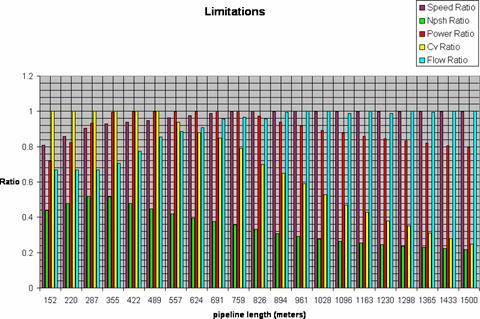

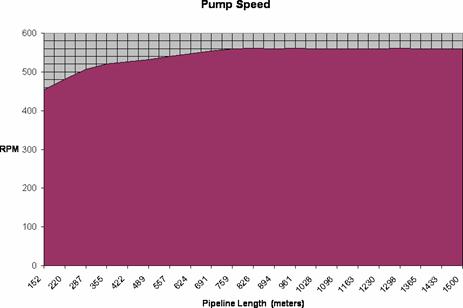
Now let’s look at using the same dredge but with adding an on-board or a remote booster pump. The second pump can be added to the dredge to eliminate the need for a floating booster or a floating booster can be added. The results we will find below are generic on how they affect the overall efficiency of the dredge as well as the operating requirements and throughput.
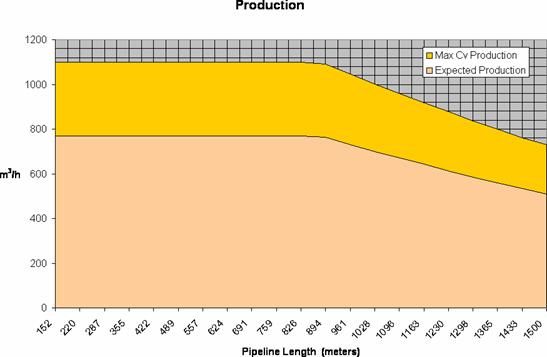
You will notice in the graph above that the EXPECTED production rate starts out around 770m 3 per hour and the dredge is now capable of holding this higher production rate out to 894 meters of discharge pipe distance. The production rate begins to drop off slightly as it moves through the discharge line. At the final discharge point of 1,500 meters, the EXPECTED production rate is now to 510m 3 per hour. This indicates that the added pump station will allow for an increase of 380m 3 per hour at the full discharge length of 1,500 meters.
We will again review some of the other graphs to see what is happening with the dredge and secondary pumping station as we did in the example above with the dredge only.
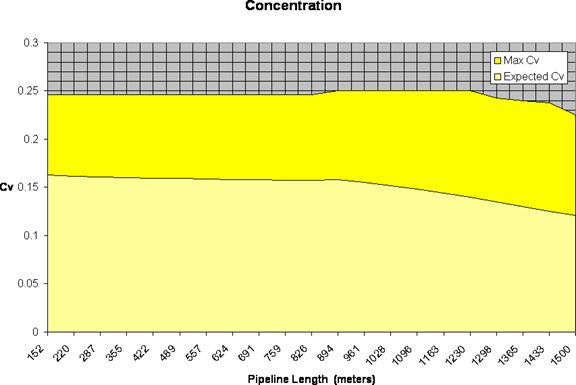
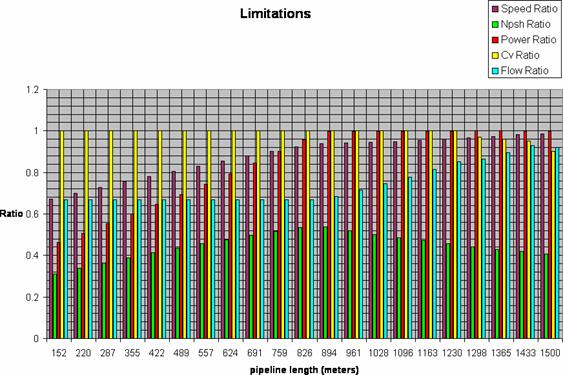
You can now see that out initial limitation is the concentration of the material. This is typically a factor of being cutter limited where the dredge is feeding to it’s capacity based on the power available to the cutter and the compaction of the material equals an excavation limit. The power required for the dredge pumps is now limited at 894 meters of discharge pipe lengh. We can also see that we continue out to full production without reaching the maximum speed of the dredge pumps. This still indicates we are limited by power to the dredge pump, but it also demonstrates how efficient the secondary pump unit can be when pumping on longer discharge lines. Additional curves are represented below for comparison to the single pump dredge configuration used for the first example.
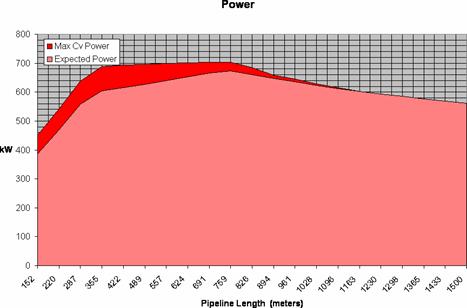
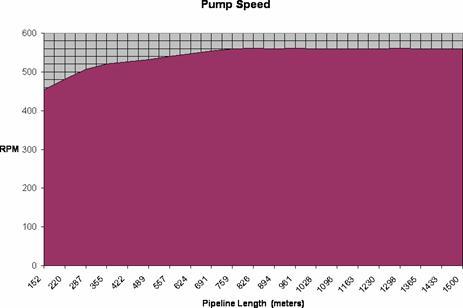
With the above examples, I will now attempt to answer your original questions in regards to dredge technology.
DDH: How do these rules affect the efficiency of the dredgers DSC is now marketing in view of the fact that most entry level dredges on offer would find it difficult to perform optimally if they are sent about 1.5 km into the water and the bund wall specified at not less than 300m from shoreline? I know boosters can come to the rescue but this alters the cost profile most new entrants will be considering.
DSC: The addition of onboard/secondary pump stations and booster pumps come with a cost. But you must evaluate the added benefit of production to evaluate the economics of using two (2) or more pumps. While I have no information relative to contract pricing, I will use some estimates and generalities to help define my position with this question.
Based on the dredge type/size that were used for the examples, lets assume an added cost to add a secondary pump unit onboard the dredge. We will also assume that the additional cost for this is US$500,000.00. Let’s assume that a dredge contractor is able to receive US$2 per cubic meter of throughput from the dredge. We already defined that the 2 pump dredge can out produce the single pump dredge by 380m 3 per hour. If we use simple math we can multiply the 380m3 x $2 per cubic meter to equal $760.00 more per hour in revenue for the 2 pump dredge. In just 658 hours of production time, the added production will equal added revenue to offset the $500,000 added price for the 2 pump dredge.
Yes – the 2 pump dredge does cost more to operate – but based on the lifespan of a dredge and the added production for 2 pumps it is very easy to see that not only is this option efficient, but also economical. My entire concept with this example was to get dredge owners to understand the full potential and to think long-term on what do they need out of their equipment.
DDH: Are there similar regulations as these in the US or any other countries or markets your company is supplying? Please name them if there are.
DSC: We are manufacturers and not dredge contractors. But I don’t know of any similar regulations in other regions, including the USA. There is the potential of site specific jobs that are considered hazardous waste areas that do have regulations, but not when dealing with pumping sand for a sea or lake. I would like to better understand what the Nigerian Government is trying to accomplish with these regulations? What are the concerns that I do not understand?
